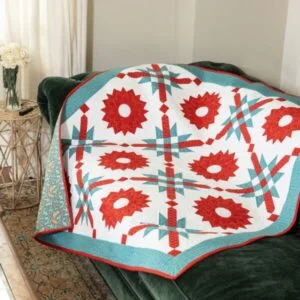The Traditional Sunflower Quilt Block is a beloved design among quilters, cherished for its intricate yet inviting pattern that brings warmth and beauty to any quilt.
Whether you’re a seasoned quilter or just starting, mastering this block can open the door to a whole range of creative possibilities. Its radiating petals and striking central circle make it a perfect focal point for larger quilt projects or a stunning standalone piece.
This quilt block, inspired by the bold and vibrant sunflower, evokes feelings of summer, happiness, and nostalgia. Quilters love how this pattern allows for creative use of fabric, letting them play with different colors and textures to mimic the natural beauty of sunflowers.

Beyond its aesthetic appeal, the Traditional Sunflower Quilt Block is also a wonderful way to practice piecing skills, working with curves, and combining various fabrics into one harmonious design.
In this guide, we’ll explore the steps to create the Traditional Sunflower Quilt Block, offer tips for choosing fabrics, and provide insights on how to perfect this timeless pattern. Let’s dive in and see how you can incorporate this beautiful block into your next quilting project.
1. Choosing the Right Fabrics for Your Traditional Sunflower Quilt Block
When starting your Traditional Sunflower Quilt Block project, selecting the right fabrics is crucial for achieving a beautiful result. The combination of colors and textures can make a significant difference in how the finished quilt block looks.
Start by choosing fabrics that mimic the vibrant colors of sunflowers. Bold yellows, deep oranges, and rich greens are often associated with this block. However, don’t be afraid to experiment with non-traditional colors that match your personal style or home décor. Whether you stick with natural sunflower shades or try something more modern, fabric selection sets the tone for the entire project.
For the center of the sunflower, a darker shade or contrasting color can work well to simulate the sunflower’s seeds. Look for fabrics with subtle patterns or textures to add depth to this part of the design. These small details can elevate the overall look of your quilt block and create a more dynamic piece.
When considering fabric texture, cotton is the most common choice for quilting due to its durability and ease of use. However, mixing in fabrics with different textures, like linen or even velvet, can give your Traditional Sunflower Quilt Block an added layer of interest. Just be mindful of fabric thickness and how it will interact with other pieces in the quilt.
Pre-washing your fabrics before beginning the project is also recommended. This prevents any shrinking or bleeding of colors later on, ensuring your Traditional Sunflower Quilt Block maintains its crisp look after completion.
Lastly, consider whether you want to use solid colors or patterns. Solids can provide a clean, modern look, while patterned fabrics add complexity and charm to the block. Mixing solids and patterns strategically can help highlight different aspects of the sunflower design, bringing your vision to life.
2. Step-by-Step Guide to Piecing Your Traditional Sunflower Quilt Block
Now that you’ve selected your fabrics, it’s time to start piecing your Traditional Sunflower Quilt Block. This block consists of several parts, including the petals, the central circle, and the background. Each part requires precision and patience, especially when working with curved seams.
Begin by cutting out all the pieces for your sunflower petals. These are usually wedge-shaped, and the number of petals can vary depending on the size of your block. Arrange them in a circular pattern, making sure the colors are balanced and pleasing to the eye.
Next, sew the petals together, piece by piece, ensuring that your seams are consistent. Use a quarter-inch seam allowance for accuracy, and take your time to avoid puckering, especially around the curves. Press your seams as you go along to keep everything flat and neat.
Once your petals are sewn together, it’s time to attach the central circle of the sunflower. This can be a bit tricky due to the curved edge, but using small, careful stitches and pinning the fabric well will help. Many quilters prefer to use a method called “appliqué” for this part, where the circle is sewn on top of the petals rather than pieced into the design.
The background pieces are the last part of the block. These typically consist of larger, solid squares or triangles that frame the sunflower. Like the petals, it’s important to keep your seams straight and press them thoroughly. The background helps the sunflower stand out, so choose a color that complements your petal and center choices.
Finally, assemble the entire block by sewing the background to the sunflower. Once everything is pieced together, give it one last press to ensure everything lays flat. Your Traditional Sunflower Quilt Block is now ready to be incorporated into a larger quilt or displayed on its own.
3. Tips for Mastering Curved Seams in the Traditional Sunflower Quilt Block
One of the most challenging aspects of creating a Traditional Sunflower Quilt Block is handling the curved seams. These seams are essential to creating the rounded, petal-like shapes that give the sunflower its iconic look, but they can be tricky for beginners.
The first tip for sewing curved seams is to go slow and steady. Rushing through these steps can lead to uneven seams, puckers, or misaligned pieces. Take your time when pinning the fabric and sewing the curve, ensuring that everything lines up perfectly.
Using more pins than usual can help you maintain control over the fabric. Since curved seams tend to shift during sewing, pinning at shorter intervals (every half-inch or so) will keep the fabric in place and prevent stretching or misalignment.
It’s also essential to clip the curve after sewing. This involves making small cuts along the seam allowance, allowing the fabric to lie flat when pressed. Be careful not to cut through the seam itself. Clipping the curve helps the block maintain its shape and keeps the sunflower looking crisp and clean.
Another helpful technique is to use a stiletto or another pointed tool to guide the fabric under the sewing machine’s needle. This tool helps you control the fabric’s movement, especially around tight curves, resulting in more accurate seams.
Practice is key to mastering curved seams. Don’t be discouraged if your first few attempts aren’t perfect. With each block, your skills will improve, and soon enough, sewing curves will feel natural.
Lastly, consider using a smaller stitch length when working on curves. A shorter stitch allows for more precise sewing and makes it easier to achieve smooth, clean lines. Experiment with different settings on your machine to find what works best for you.
4. Incorporating the Traditional Sunflower Quilt Block into Larger Projects
The Traditional Sunflower Quilt Block can stand alone as a beautiful focal piece, but it’s also a versatile design that works well in larger projects. Incorporating this block into quilts, wall hangings, or even pillows can bring a touch of nature-inspired beauty into your home.
One popular way to use the Traditional Sunflower Quilt Block is to combine it with other floral-themed blocks. Pairing the sunflower block with other designs like daisies, tulips, or roses creates a quilt that celebrates the beauty of the garden. This approach allows you to experiment with different colors and patterns while maintaining a cohesive theme.
Another option is to use the sunflower block as the centerpiece of a quilt. Surrounding it with simpler, geometric blocks helps to draw attention to the sunflower while creating a balanced, eye-catching quilt. The contrast between the intricate sunflower and more straightforward blocks can create a dynamic visual effect.
For those who prefer a more modern look, using the Traditional Sunflower Quilt Block with a minimalist background can give the design a contemporary twist. Opt for neutral or solid-colored backgrounds that let the sunflower pop, emphasizing the block’s bold design.
Additionally, the Traditional Sunflower Quilt Block can be scaled down or up depending on your project’s needs. A larger block can serve as a statement piece for a quilt or wall hanging, while smaller blocks can be repeated throughout a quilt for a more uniform look.
Finally, consider using your finished Traditional Sunflower Quilt Block in non-traditional ways. For example, you can transform it into a decorative pillow cover, a quilted tote bag, or even frame it as a piece of textile art. The possibilities are endless with this versatile block, and it’s a great way to showcase your quilting skills.
FAQ
What size should the Traditional Sunflower Quilt Block be?
The size of the Traditional Sunflower Quilt Block can vary based on your project, but it’s commonly created in sizes ranging from 12×12 inches to 18×18 inches. You can scale it up or down depending on your needs.
Is the Traditional Sunflower Quilt Block suitable for beginners?
While the Traditional Sunflower Quilt Block may be challenging for absolute beginners due to its curved seams, it’s a great block for quilters looking to improve their piecing skills.
What fabric works best for the Traditional Sunflower Quilt Block?
Cotton is the most popular choice for quilting projects, including the Traditional Sunflower Quilt Block, but mixing textures can add interest. Solid colors, patterns, and textured fabrics all work well.
Can I use different colors for my Traditional Sunflower Quilt Block?
Absolutely! While traditional sunflower colors include yellow, orange, and green, feel free to experiment with different shades and patterns to make your block unique.
How many sunflower blocks should I use in a full-sized quilt?
The number of Traditional Sunflower Quilt Blocks depends on the size of your quilt and the size of each block. For a standard-sized quilt, you might need anywhere from 12 to 20 blocks, depending on their dimensions.
How do I care for a quilt with the Traditional Sunflower Quilt Block?
Wash your quilt in cold water on a gentle cycle. If your quilt contains different textures, handle it with extra care and avoid using harsh detergents.
Join our VIP broadcast list and gain access to exclusive patterns, all for free. As a VIP member, you’ll receive the best patterns daily, delivered directly to your device. ✨📱 It’s a unique opportunity to stay up-to-date with the latest trends and designs, curated just for you. Don’t miss out on enhancing your projects and discovering new inspirations with the best patterns every day! 🎨🔝
Conclusion
The Traditional Sunflower Quilt Block is a timeless design that combines beauty, challenge, and versatility. Whether you’re creating a single block to showcase or incorporating it into a larger project, this block offers endless possibilities.
We hope this guide has inspired you to start your own sunflower quilt block and experiment with different colors and textures. Don’t forget to leave your feedback and suggestions in the comments—we’d love to hear about your experiences!



